The Samsung Galaxy Tab S2 Review
by Brandon Chester on October 15, 2015 8:00 AM ESTSystem Performance
Tablets have always been devices where performance can be pushed further than a smartphone. There's much more thermal headroom and bigger batteries to drive high performance SoCs. Both Apple and NVIDIA have SoCs that cannot feasibly be put in a smartphone due to their heat and power usage, and these chips find their way into tablets where these factors can be managed and the additional performance can be utilized by more sophisticated applications. At the same time, some vendors opt to use the same silicon in both phones and tablets. In the case of the Galaxy Tab S2, Samsung has decided to use their Exynos 5433 SoC which previously shipped in the Galaxy Note 4 Exynos.
The CPU side of Exynos 5433 is a quad core Cortex A57 cluster with a max frequency of 1.9GHz, and a quad core Cortex A53 cluster with a max frequency of 1.3GHz. The GPU is ARM's Mali-T760 MP6 GPU with a max frequency of 700MHz. On average the results should be similar to the Galaxy Note 4 Exynos, although software improvements to both the browser as well as Android itself will obviously have an impact.
As always, the first group of tests are our web browser tests to characterize JavaScript performance, followed by BaseMark OS II and PCMark to evaluate the CPU and other aspects of a device's performance.
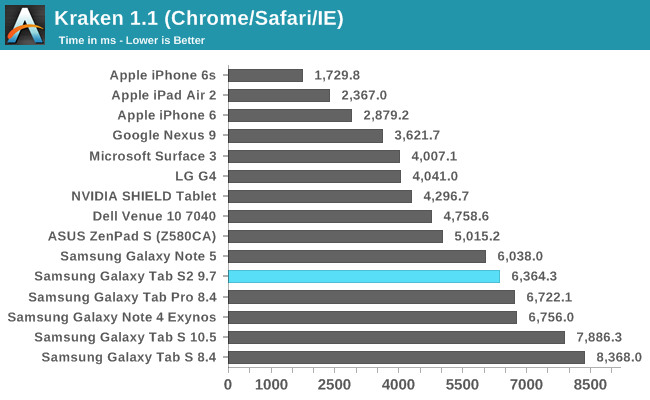
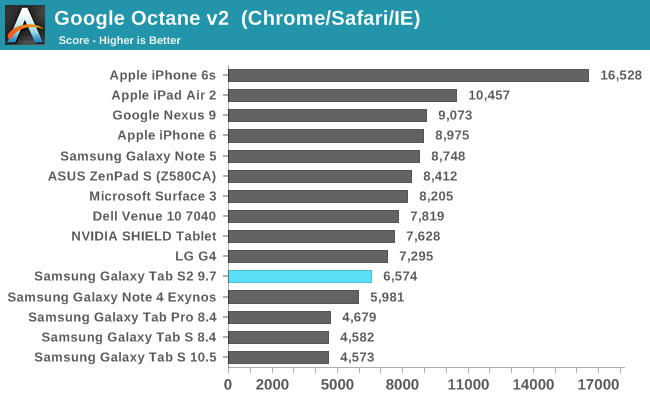
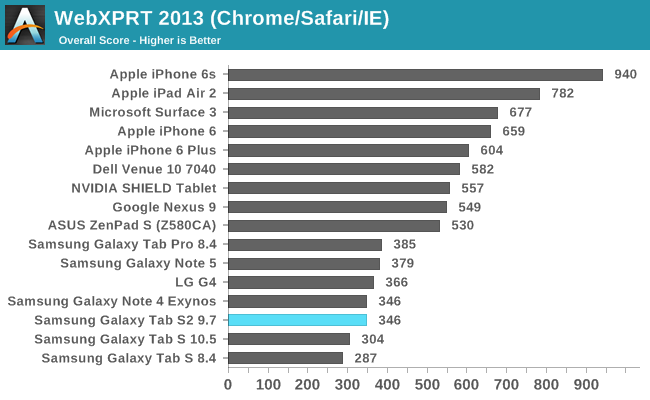
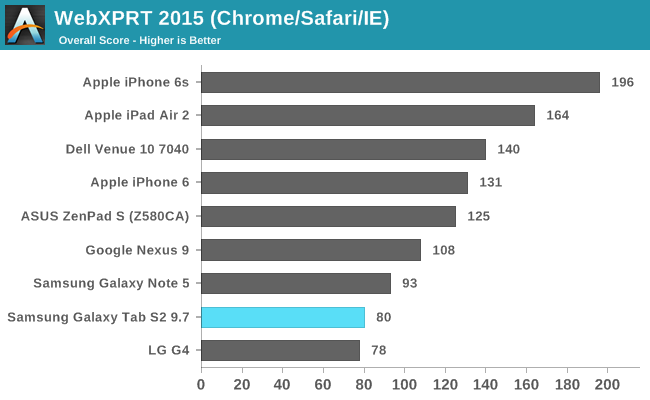
Android, and most specifically Chrome's lackluster JavaScript performance is something we've been commenting on for a while now. On top of that, the Galaxy Tab S2 simply doesn't have Samsung's latest and greatest SoC, and these factors combined together give results that aren't very impressive when one considers how much better the iPad Air 2 performs despite being over one year old at this point.
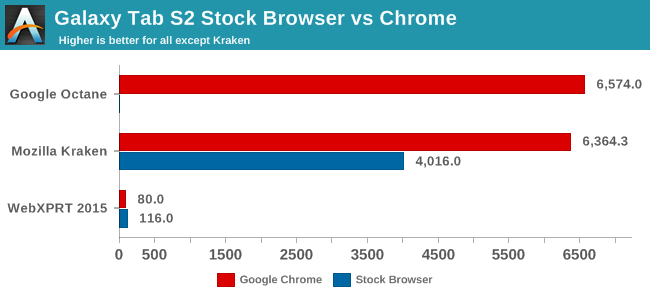
Looking at the Javascript performance in Samsung's stock browser provides some interesting but not unexpected data. It's clear that there's a much higher degree of optimization for Samsung's SoCs in their own browser than in Chrome, which isn't surprising. However, Samsung's browser isn't without its own issues. It actually crashes in the zlib test of Google Octane, and although the incomplete score of 7354 is higher than what Chrome achieves, the fact that the JavaScript code couldn't be properly executed points to some more concerning issues than performance
The other problem with using a device's stock browser for comparisons is that Android devices shipping with Google Mobile Services also include Chrome, and in my experience users are far more likely to utilize Chrome based on their awareness of the Chrome brand than they are to use the included OEM web browser. In short, while stock browser results may give a better idea of what kind of JavaScript performance a device is technically capable of, the Chrome results are more relevant when examining the performance and experience that the average user will have.
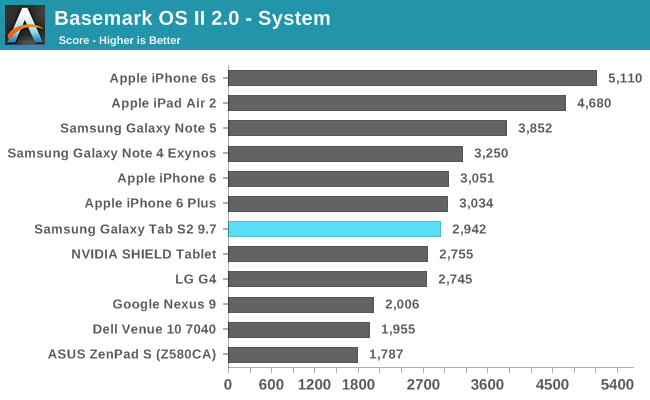
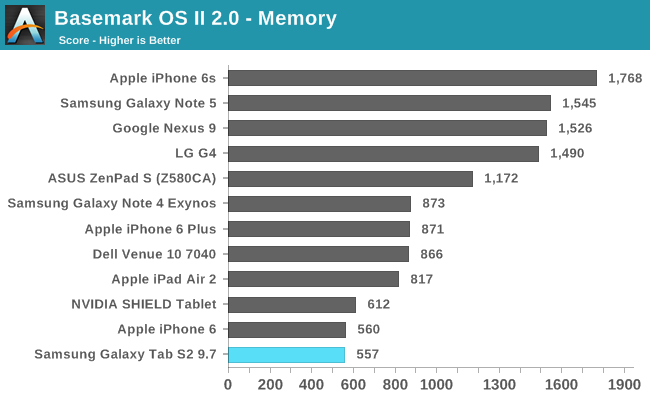

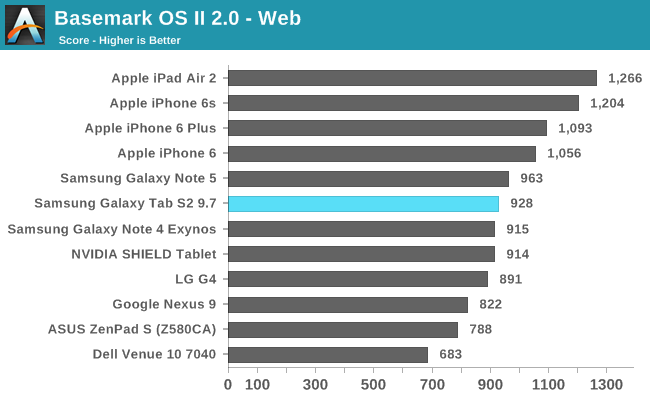
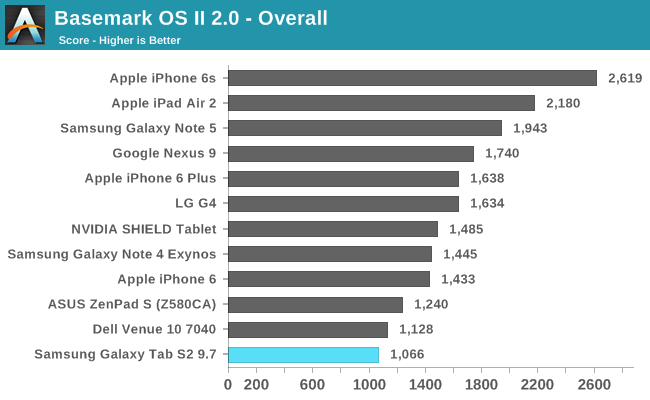
When examining the overall score in BaseMark OS II one may think that the Tab S2 performs extremely poorly. However, when looking at the sub tests it becomes clear that the overall score is being brought down by very low storage and graphics scores. What's surprising is the large gap between the graphics resuIts on the Tab S2 and the Galaxy Note 4 Exynos which uses the same Exynos 5433 SoC. I re-ran the benchmark several times to see if there was anything strange going on but there doesn't appear to be any problem with the testing, and I'm not quite sure why there's such a large gap between the two.
Moving past storage and graphics, the Tab S2 gets fairly good scores in the web and system tests. However, it still lags very far behind the iPad Air 2, and there's really no way to excuse this when both devices cost the exact same amount.
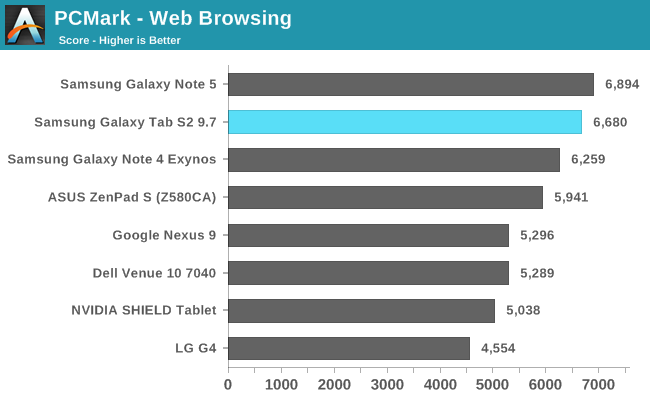



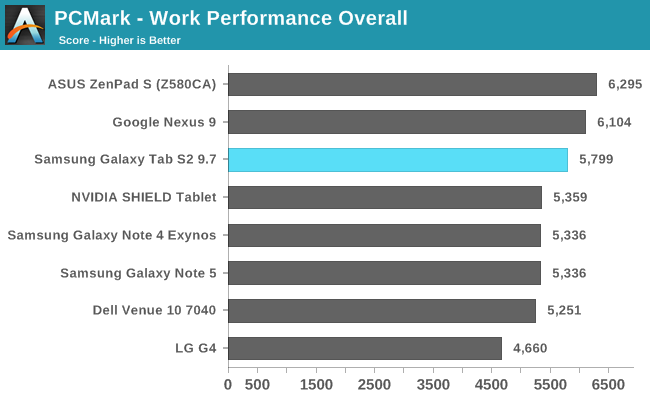
PCMark is still an Android only benchmark so the results here will strictly be comparing to other Android tablets. Overall, the Tab S2 does well. Upon examining the sub tests it can be seen that the Tab S2 is always fairly close the top of the charts, with certain devices achieving extraordinary scores in some tests which makes the Tab S2 look comparatively slower than it would be with more devices for comparison.
Exynos 5433 is not Samsung's best silicon, and even Exynos 7420 would likely struggle to compete with an SoC designed exclusively for full sized tablets. In the end the Tab S2's performance is just not competitive with the iPad Air 2 or even the Nexus 9 which is priced at $399 and often sells for even less. If I were looking at the 8" Tab S2 I would probably consider its performance acceptable relative to the competition at that size and price, but the market segment of full sized flagship tablets costing $500 or more is a completely other story.
I think Samsung definitely needs to reconsider their process of designing tablets, and part of that has to involve using chips that befit the larger size and greater capabilities of a tablet compared to a smartphone. It's in everyone's best interest to not have one company holding an enormous performance lead in any market, and if there's any company that has the capabilities, integration, and resources to fight with Apple over the tablet performance crown I would think it would be Samsung.










162 Comments
View All Comments
name99 - Thursday, October 15, 2015 - link
"You can't really notice a difference between its 5.6mm thickness and the 6.1mm thickness of the iPad Air 2, but the difference made by the lower mass is enormous."Really? The iPad Air 2 weighs 437 grams. The Tab S2 at 389g is about 10% less. I'm not doubting you, but that does not seem a small enough difference to justify the superlatives you are using.
I guess we'll see how much of this is psychological when the Air 3 lands next Spring; I imagine it will be around 400g.
Tech_guy - Thursday, October 15, 2015 - link
Ouch. This review just shows Apple's dominance, especially in graphics and web scores. Samsung and Android have their work cut out for them. It's amazing how powerful A9 is in graphics. I mean dang.beggerking@yahoo.com - Friday, October 16, 2015 - link
they picked and chose benchmarks. notice it showed none of the mutil-cpu benchs?Anandtech is way biased now
Tech_guy - Saturday, October 17, 2015 - link
The only multi-core benchmark is geekbench multi-core. Everything else just runs faster on iPhone 6sTech_guy - Thursday, October 15, 2015 - link
I can't imagine ever buying this thing over an iPad air 2. Samsung is not competitive in tablets anymore at all IMO. Plus iPad has always had MUCH better tablet apps. I think Android tablets will eventually die off, they need to.Pramod - Thursday, October 15, 2015 - link
It seems, in galaxy s6, nexus 6 and lg g flex 2, diamond pentile displays have four sub pixels instead of two. Gsmarena suggests this and they have optical microscope images with a scale bar. Can anandtech take a look and confirm this (or debunk it)?Pramod - Thursday, October 15, 2015 - link
And may be look at galaxy tab s2 display pixel arrangement too.Pramod - Thursday, October 15, 2015 - link
It seems that in newer amoled displays (nexus 6, galaxy s6, lg g flex 2, etc) the diamond pentile arrangement has 4 sub pixels instead of two. This was suggested by another review website. Can anandtech confirm this with microscope images with scalebar on galaxy tab s2?edzieba - Friday, October 16, 2015 - link
'Diamond' Pentile has a four-subpixel arrangement (RGBG), but LOGICALLY addresses only two subpixels per pixel. Or to put it another way, the green subpixels are at the logical resolution, but red and blue are at half that density.There is RGBW Pentile that adds in a White subpixel, but this is also logically addressed as two subpixels per pixel.
Pramod - Tuesday, October 27, 2015 - link
No, the blue sub pixels are at twice the density and the red and green are at the advertised ppi.